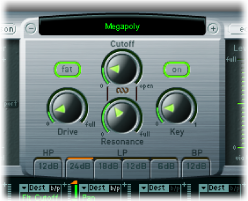Working with EXS24 mkII Filter Parameters
These parameters control the EXS24 mkII filter section. You can configure the type of filter, filter resonance, cutoff frequency, drive, and amount of key follow. For details about the filter envelope, see Getting to Know the EXS24 mkII Envelopes (ENV 1 and ENV 2).

- Filter On/Off button: Activates or deactivates the entire filter section and the filter envelope. Deactivating the filter section makes it easier to hear adjustments to other sound parameters, as the filter always heavily affects the sound. Disabling the filter also reduces processor load. If the button is green and labeled On, the filter is engaged. If it’s gray and labeled Off, the filter is disabled.
- Filter Mode/Slope buttons: Appearing as HP, LP, and BP at the bottom of the section, these buttons determine the type, and slope, of the filter. See Choosing the EXS24 mkII Filter Mode (HP, LP, BP).
- Cutoff knob: Sets the cutoff frequency of the filter. The Cutoff value also serves as the starting point for any modulation involving the filter. See Using EXS24 mkII Filter Cutoff and Resonance Parameters.
- Resonance knob: Boosts or cuts the frequency area surrounding the cutoff frequency. Very high Resonance values introduce self-oscillation, causing the filter to produce a sound—a sine wave—on its own. See Using EXS24 mkII Filter Cutoff and Resonance Parameters.
- Drive knob: Overdrives the filter input. Turning Drive up leads to a denser, more saturated signal, which introduces additional harmonics. See Overdriving the EXS24 mkII Filter.
- Key knob: Defines the amount of filter cutoff frequency modulation by note number. When Key is set to the full-left position, the cutoff frequency is unaffected by the note number and is identical for all played notes. When Key is set to the full-right position, the cutoff frequency follows the note number 1:1—if you play one octave higher, the cutoff frequency is also shifted upward by one octave. This parameter is useful for avoiding overly filtered high notes.
- Fat (Fatness) button: Enables or disables the fatness feature. Fatness preserves the bass frequency response of the loaded sampler instrument, even when high Resonance settings are used.
Note: The Fatness parameter applies only to lowpass filters. Fatness is nonfunctional when the highpass or bandpass filter types are active.
Choosing the EXS24 mkII Filter Mode (HP, LP, BP)
The EXS24 mkII filter can operate in several modes, allowing specific frequency bands to be filtered (cut away) or emphasized.
Select one of the following buttons at the bottom of the filter section to choose a filter mode:
- HP (highpass): This filter type allows frequencies above the cutoff frequency to pass. The slope of the highpass filter is fixed at 12 dB/octave in HP mode.
- LP (lowpass): This filter type allows frequencies that fall below the cutoff frequency to pass. Click any of the four buttons under the LP label to engage the lowpass filter, and choose a filter slope: 24 dB (4 pole), 18 dB (3 pole), 12 dB (2 pole), and 6 dB (1 pole). The 24 dB setting can be used for drastic effects, such as cutting off all but a few notes. The 6 dB setting is useful for creating a slightly warmer sound, without drastic filter effects—to smooth overly bright samples, for example.
- BP (bandpass): The frequency band directly surrounding the cutoff frequency is allowed to pass. All other frequencies are cut. The Resonance parameter controls the width of the frequency band. The bandpass filter is a two-pole filter with a slope of 6 dB/octave on each side of the center frequency of the band.
Using EXS24 mkII Filter Cutoff and Resonance Parameters
The following section outlines the impact of the filter’s Cutoff and Resonance parameters. If you’re new to synthesizers, and the concepts behind filters, see Filters in Synthesizer Basics.
The Impact of Cutoff Frequency on the Signal
The Cutoff Frequency (Cut) parameter controls the brilliance of the signal.
In a lowpass filter, the higher the cutoff frequency is set, the higher the frequencies of signals that are allowed to pass.
In a highpass filter, the cutoff frequency determines the point where lower frequencies are suppressed, with only upper frequencies allowed to pass.
In a bandpass/band-rejection filter, the cutoff frequency determines the center frequency for the bandpass or band-rejection filter.
The Impact of Resonance on the Signal
The Resonance (Res) parameter emphasizes or suppresses portions of the signal above or below the defined cutoff frequency.
In a lowpass filter, resonance emphasizes or suppresses signals below the cutoff frequency.
In a highpass filter, resonance emphasizes or suppresses signals above the cutoff frequency.
In bandpass filters, resonance emphasizes or suppresses the portions of the signal—the frequency band—that surround the defined frequency, set with the Cutoff Frequency parameter. Alternatively, resonance can be used to define the width of the frequency band. This is how it is used in the EXS24 mkII.
Controlling Cutoff and Resonance Simultaneously
Changing the Cutoff and Resonance controls at the same time is key to the creation of expressive synthesizer sounds.
Drag the chain symbol between the Cutoff and the Resonance knobs to control both parameters simultaneously—vertical movements alter Cutoff values, and horizontal movements affect Resonance values.

Overdriving the EXS24 mkII Filter
The filter is equipped with an overdrive module. Overdrive intensity is defined by the Drive parameter.
The filter Drive parameter affects each voice independently. When every voice is overdriven individually—like having six fuzz boxes for a guitar, one for each string—you can play extremely complex harmonies over the entire keyboard range. They’ll sound clean, without unwanted intermodulation effects spoiling the sound.
Furthermore, appropriate Drive parameter settings lead to a different tonal character. The way analog filters behave when overdriven forms an essential part of the sonic character of a synthesizer. Each synthesizer model is unique in the way its filters behave when overdriven. The EXS24 mkII is quite flexible in this area, allowing tonal colors that range from the most subtle fuzz to the hardest of distortions.